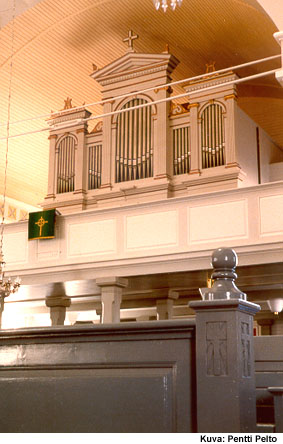|
HISTORICAL ORGANS IN FINLAND 
Luumäki Church- Thulé, Bror Axel 1908
- 25 stops, 2 manuals and pedal
- pneumatic action and pneumatic stop action
Luumäki Church is a cruciform Empire-style (Neo-Classical) church with a bevelled ceiling. Its plans were drawn up by the Office of Public Works, and it was completed in 1845. The Bror Axel Thulé organ was completed in 1908. It is a rather large instrument, with 25 stops. Apart from the addition of a blower, it has remained unchanged. Its size alone grants it a place in the history of Finnish organ building, and it is also a fine example of Bror Axel Thulé’s late period.
Façade and structure
The Neo-Classical façade has five flats; the middle and outermost ones have conspicuous tops and grooved Ionian pillars. The middle flat is topped with a pediment with a cross above it, while the outermost flats are oblong and have harp decorations. Between these three there are two lower flats. The horizontal strip under the façade pipes — the upper board — is rich and broad. The façade structures are painted white, and the decorations are gilt.
The organ design is in-line: behind the façade is the Manual I chest, followed by the maintenance access space and the Manual II swell box. The Pedal chest is at the rear. Under the organ is a large double rise reservoir from which channels lead directly to the chests.
Technical features
The chests are pneumatic stop channel chests of the type developed by B.A. Thulé; by this time, they had evolved into the shape that persisted until the 1960s.
The console is in front of the organ, and the organist sits with his back to the instrument. The stop tabs are above the manual keyboards, and above them are the small knobs of the free combination. The general crescendo pedal is beside the swell pedal. The action is pneumatic. Thin lead pipes convey the air to the small relay and pallet bellows.
Musical properties
The Luumäki organ has a pneumatic action that is light and easy to use. The slight delay in speaking is simple to get used to. The pneumatic action was the high-tech of its time; the music of that period did not require precise articulation.
The Luumäki organ is a late work of B.A. Thulé. Nevertheless, it still reflects the late 19th-century tradition. Manual I has loud and strong stops, echoed on Manual II by similar but narrower stops. Several such pairs can be identified: Borduna/Gedacht piano, Principal/Geigenprincipal, Hohlflöjt/Liebl.Gedacht, Octava/Gambetti, Trompete/Oboe. Despite the apparent repetition, Manual II is not just a diminutive copy of Manual I; the manuals are distinctive instruments with profiles differing from the practice of classical organ building. There is only one overblowing stop. The quiet pair of undulating stops Aeoline/Voix celeste on Manual II is a Late Romantic feature. The large number of 8’ stops shows that the builder was aiming for refined gradation of tonal colour and a seamless dynamic scale.
The sound is powerful, dark and penetrating. The automatic pedal changer disengages the I-Ped coupling when the organist moves to Manual II.
Disposition
Manual I C-f3 | Manual II C-f3 | Pedal C-d1 |
Borduna 16 | Gedacht piano 16 | Principalbass 16 |
Principal 8 | Geig.principal 8 | Subbas 16 |
Gamba 8 | Liebl.gedacht 8 | Principal 8 |
Hohlflöjt 8 | Flauto amabile 8 | Gedacht 8 |
Konsertflöjt 8 | Aeoline 8 | Octava 4 |
Qvintatön 8 | Voix celeste 8 | Bassun 16 |
Octava 4 | Gambetti 4 | I-Ped |
Flöjt 4 | Flauto octaviante 4 | II-Ped |
Mixtur 3f | Oboe 8 | |
Trompete 8 | | |
II-I | | |
II-I 16 | | |
| | |
|
|
|
mezzoforte, forte, tutti | | |
One free combination, general crescendo pedal, Pedal changer | | |
Manual II in swell box | | |
| | |
| | |
| | |
| | |
| | |
| | |
| | |
| | |
| | |
| | |
|